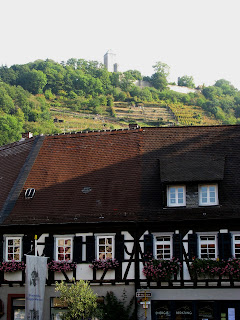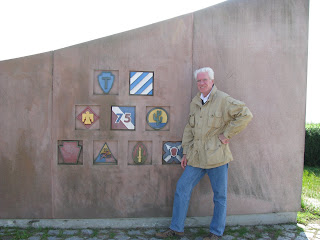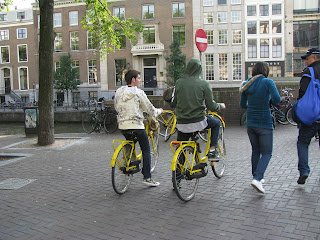
We arrived in Kaysersberg just before 3 p.m. and checked into our hotel, Les Ramparts. We stowed our gear and quickly set out into the town to have some lunch and then tour the town. I had the standard baguette of jambon, fromage, pickles and moutard, washed down with a glass of local brew. My father was wounded here on December 16, 1944 and awarded the Bronze Star with a V for Valor on the 17th so our plan is to walk around as much as possible figuring that at some point, we have to trod over some ground that he trod on during his time here. I asked the Mademoiselle who served the sandwiches if she knew where there were any WWII monuments and she mentioned the Musee (Albert Schweitzer Museum) and the Chateau,

which high on a hill right behind the town.
A quick recon of the town

revealed no WWII monument but the main street heading north towards Colmar is named

Rue de 18 Decembre, which is a start. We decided to climb the hill to the chateau (this is wine country and the hillsides are all planted with vines), only about 200+ feet up. A few inquiries got us pointed in the right direction. As we cut around the back of the church, we found the graves and a memorial to 18 French Soldiers (1st Div),

all of whom died on 18 Decembre, 1944, so it would appear that the street of the same name has no relationship to the 3rd Division.
We climbed the stairs up to the chateau, and then up above it to see if we could get a shot of the town. We worked our way to a dirt road that ran across the hill, providing access to the vines that covered the hill. We took some shots and walked back towards the steps. Dave discovered a steel reinforced concrete structure built into the side of the hill that looked like a pillbox.

It appeared to go back into the hill. We climbed around to the back and found where it came out. I thought it could have been an aquifer, used to channel water for the vines or control runoff. We found some block and mortar structures later that were just that, but this was steel reinforced concrete.
After some debate, we decided to climb to the top of this hill. Twenty minutes later, drenched in sweat, we reached this cell phone tower and a road. We took the road heading down, and eventually came out right behind our hotel. After a long hard climb and a long walk down, we had worked up quite a thirst. And there’s only one way to slake a thirst like that

.
A little before 9pm, we went down to have dinner at a place recommended by the desk clerk. We got there, studied the menu posted outside the door, waltz in and were advised the kitchen was closed. Disappointing to say the least as the menu looked great and we were a tad hungry. We were now quite concerned that we were too late to eat in town and faced with the prospect of a long night, or driving 10+ kilometers to Colmar and end up eating at the embassy (McDonalds—giving the nickname “the embassy” by Nick in Santiago). We went to the restaurant next door, sorry, closing, try the place on the corner. Fortunately, they were still open. We ordered fois gras, pork (actually ham) with potato salad, venison stew and pigs knuckle mit der kraut. The venison stew was incredible and was served with a red sauerkraut and a doughy pasta. The ham came with the best potato salad I have ever had and horseradish. The horseradish was like wasabi, absolutely fantastic. There was some discussion over the pigs knuckle and our French being as deficient as the wait staffs English, no one new wtf. It seemed to us they were telling us it was huge, a lot to eat, but we said ok bring it anyway. We got the first three items and had pretty much polished of the Pinot noir (Alsace), so we ordered another bottle. Out comes the wine, yes it’s fine, fill the glasses and then the waiter is asking if we want desert. No, bring out the pigs knuckle. No, no, no pigs knuckle, we thought you didn’t want it. Merde! !@*$#% merde. We had already seen the cooks come out of the kitchen so we knew we were screwed. C’est le vie. Nothing to do but drink the wine and forget the tip. But I was really looking forward to that pigs knuckle.
On our way to Kaysersberg, we decided to stop in Metz, as Patton left for near there to go to Bastogne, so it seemed to fit. We were only there an hour, but we had a nice chat with a guy from Germany who obliged us with a picture.

After dinner, we took our bottle of wine to an outside table to finish it. Dave went back across the street to the first place we tried for dinner (they still were serving café and drinks) to make some inquiries about the 3rd Div. (their English was pretty good) but didn’t have much luck. A few minutes later, the kid to whom he was talking came across the street and gave use some info on a Third Div site in Muenster. He then came back a second time, apologizing for the intrusion and gave us some more info. Hey kid, no problemo.

 on the same train, in the same car,
on the same train, in the same car,  at the same table, in the same hotel room, sharing a bathroom, no one to run interference or act as a buffer and not kill him or be killed by him.
at the same table, in the same hotel room, sharing a bathroom, no one to run interference or act as a buffer and not kill him or be killed by him.  Oh we growled at each other a couple times, but for two guys with 47 years of ideosyncracies (his are way more annoying than mine) since our last trip together,
Oh we growled at each other a couple times, but for two guys with 47 years of ideosyncracies (his are way more annoying than mine) since our last trip together,  we managed to tolerate each other very well,
we managed to tolerate each other very well,  a lot like those two guys who went to Port Jefferson all those years ago, not just brothers but friends.
a lot like those two guys who went to Port Jefferson all those years ago, not just brothers but friends.















































